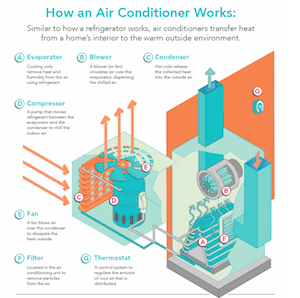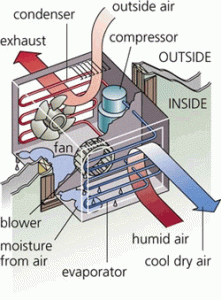
We all enjoy our air conditioners in the summertime. But did you ever wonder how that machine creates such wonderful cool air? Home Comfort Experts offers a simplified version of how your air conditioner works to help you understand and appreciate this amazing piece of equipment.

Air Conditioner Parts
An air conditioner works in a way that is very similar to the way that a refrigerator works. It transfers heat from inside the home to the outside. It is made up of several parts that all work together to keep a home cool. An air conditioner has evaporator coils, a blower motor, condenser coils, a compressor, a fan, a filter and a thermostat. If we break down what each component does, we can understand how the whole system works. This photo from Energy.gov website helps to illustrate the individual parts.
Evaporator Coils Remove Humidity
The evaporator coils use a refrigerant to remove humidity and heat from the air. The blower disperses the chilled air by circulating it over the evaporator.
The Condenser Coils Release Heat Outside
A fan dissipates the heat outside by blowing the air over a condenser. The condenser coils release the heat into the air outside.
Filters Keep the Air Clean
The filter can be found inside of the air conditioner. It removes particles from the air. This helps prevent dust and other types of allergens from circulating throughout your home.
The Compressor Pumps the Refrigerant between the Evaporator & the Condenser
The compressor is a pump that moves the refrigerant between the condenser coils and evaporator coils. This helps keep the air inside of the home cool.
The Thermostat Tells the AC to Turn on or off to Achieve a Desired Temperature
A thermostat is a tool that regulates the amount of cool air that the air conditioner distributes. Lowering the temperature of the thermostat will increase the amount of cool air that is distributed. Likewise, raising the thermostat temperature will decrease the amount of cool air distributed. However, lowering the temperature on an thermostat severely will not make your air conditioner cool your home any faster.
Your Air Conditioner Pulls Humidity from the Air
An air conditioner also helps reduce moisture in the air. When the air is humid, the body has a harder time cooling itself. That is why we feel hotter when there is more humidity in the air.
Keep in mind that there are several different types of air conditioners. This includes central air conditioners, room air conditioners, ductless mini-split air conditioners and evaporative coolers. Every type of air conditioner has its advantages and disadvantages.



